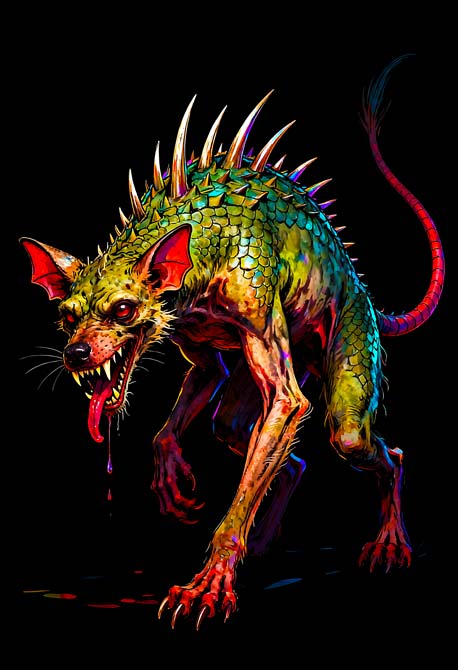
Chupacabra
Type: Cryptid / Quadruped
Region: The Americas (Primarily Puerto Rico, Mexico, Southern United States)
Description: The Chupacabra — whose name translates to “goat-sucker” in Spanish — is a vampiric creature infamous for attacking livestock, especially goats, and draining them of blood. Descriptions vary widely: early accounts from Puerto Rico in the mid-1990s describe a reptilian, bipedal creature standing 3–4 feet tall, with gray-green scaly skin, sharp quills or spines along its back, and large red eyes that glow in the dark. Later sightings across Mexico and the American Southwest depict a more canine form — a hairless, mangy beast with fanged jaws, leathery skin, and an unnatural gait. Despite the conflicting imagery, all share a single hallmark: a thirst for blood.
Behavior: The Chupacabra is nocturnal and elusive, striking under cover of darkness. It leaves behind victims drained of blood through small puncture wounds, often with no signs of struggle. Some witnesses claim it moves in short, hopping bursts like a kangaroo; others say it stalks like a coyote or prowls on all fours. Sightings often follow reports of mutilated livestock, strange tracks, or eerie screeching cries echoing through rural farmland. Its intelligence and cunning have led some to speculate it may not be of earthly origin.
Cultural Significance: Since its first reported attacks in Puerto Rico in 1995, the Chupacabra has become one of the most recognizable modern cryptids — a symbol of rural fear, media frenzy, and the blurred line between folklore and fact. Its legend spread rapidly across Latin America and into the United States, inspiring documentaries, horror films, and countless local tales. Whether viewed as a cryptid predator, a government experiment gone wrong, or an alien interloper, the Chupacabra remains a chilling emblem of mystery and modern myth.
